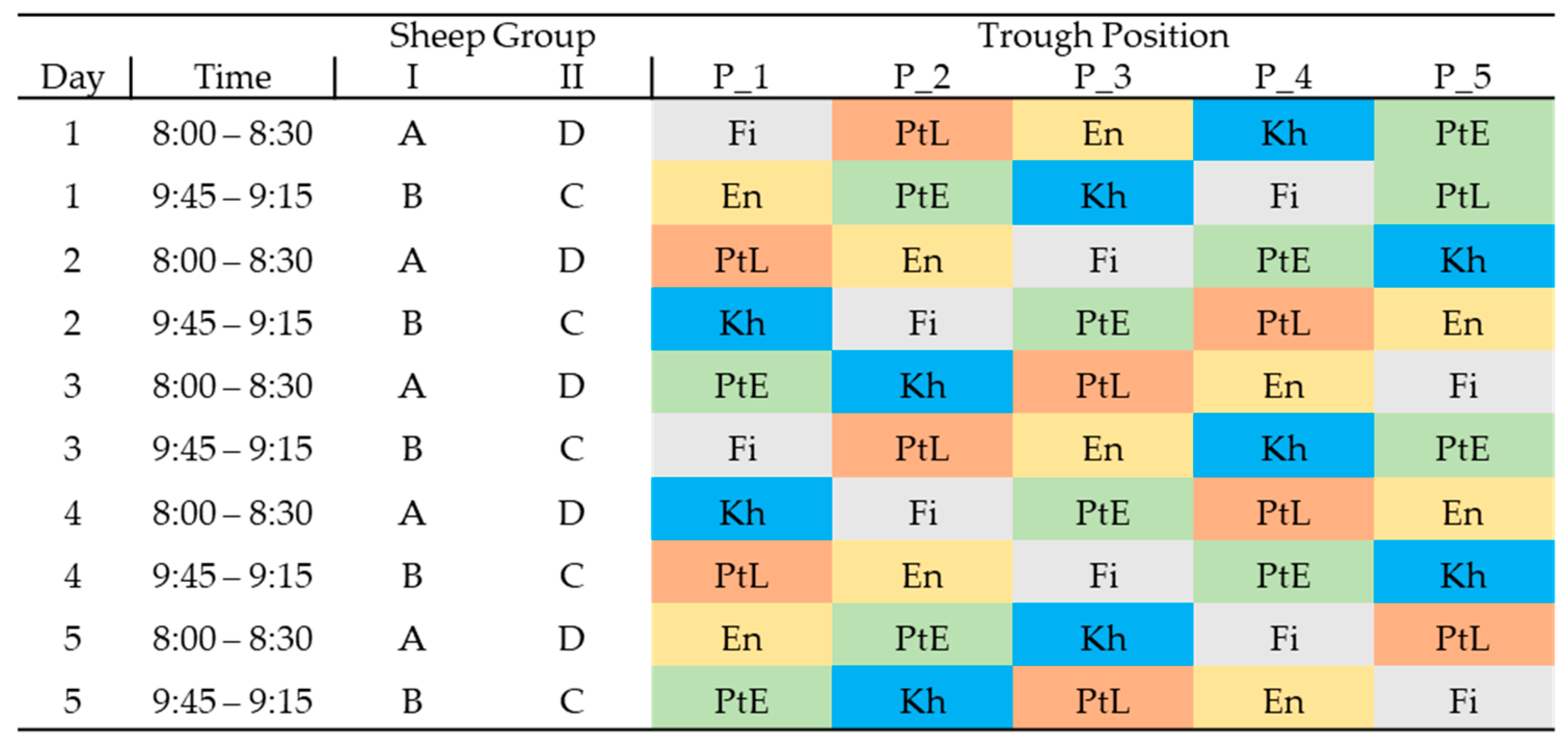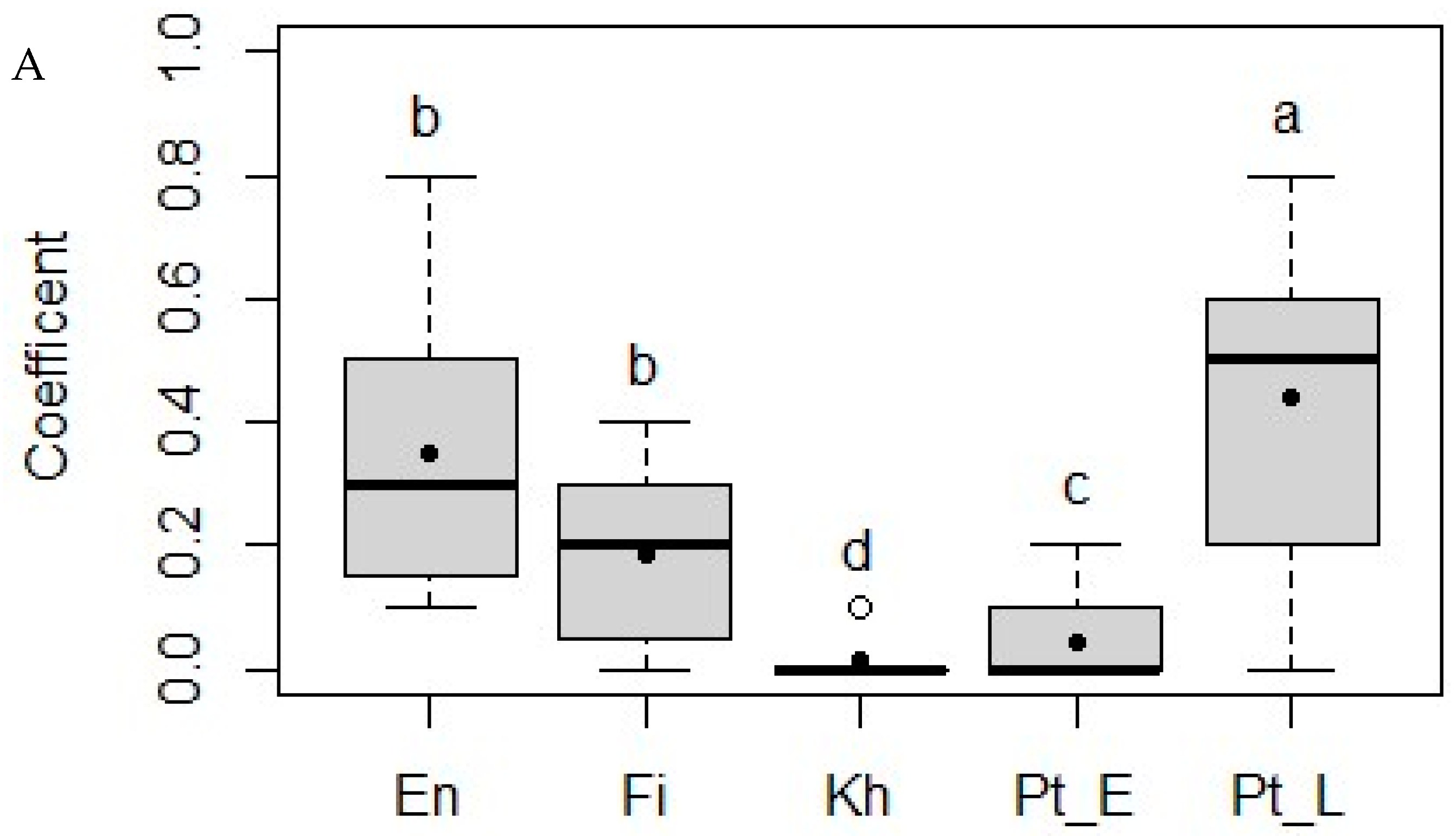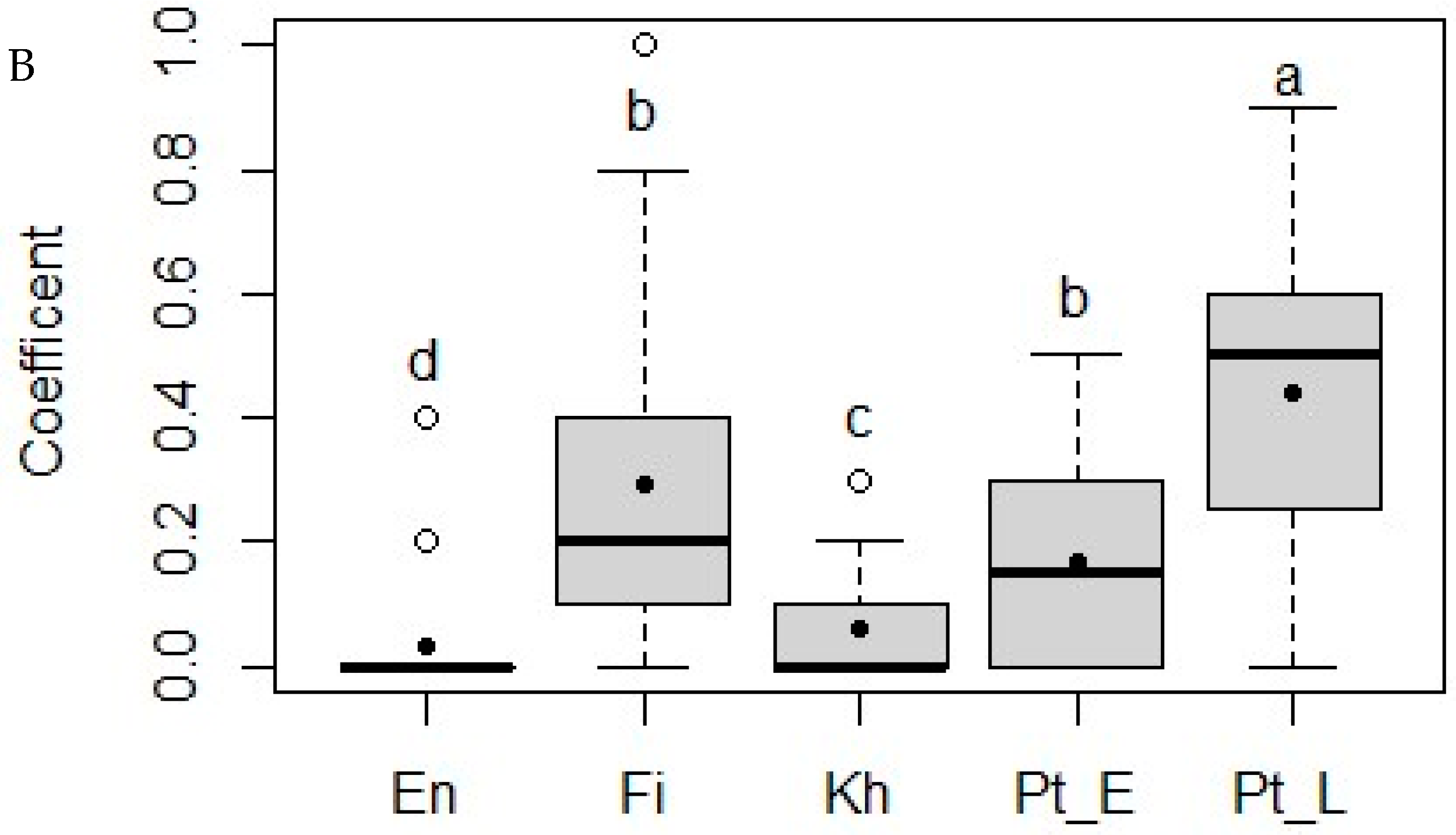Preference of Ligneous Forages by Sheep in South-East Mali
Simple Summary
Abstract
1. Introduction
2. Materials and Methods
2.1. Study Site
2.2. Experimental Animals and Woody Forages
2.3. Experimental Design and Procedures
2.4. Plant Sample Analysis
2.5. Data Analysis
3. Results
3.1. Chemical Composition of Leaves
3.2. Quantitative Intake of Leaves
3.3. Consumption Time and Preference of Woody Species
4. Discussion
4.1. Nutritional Quality of Woody Forage Species
4.2. Preference of Woody Forages by Sheep
5. Conclusions
Author Contributions
Funding
Institutional Review Board Statement
Informed Consent Statement
Data Availability Statement
Acknowledgments
Conflicts of Interest
References
- Stefanis, C. Global Food Security: An agricultural perspective. J. Agric. Sustain. 2014, 6, 69–87. [Google Scholar]
- Kanazoe, P.O.O.; Zabre, G.; Kabore, A.; Konate, A.; Traore, A.; Tamboura, H.H.; Belem, A.M.G.; Millogo, J.; Legma, B. Effects of supplementation with dried leaves of Calotropis procera (Willd.) R. Br. on growth performance and parasite load in sheep during the rainy season in Burkina Faso. Int. J. Biol. Chem. Sci. 2018, 11, 20–28. [Google Scholar]
- Dhakal, S.; Subedi, B.; Khanal, N.; Devkota, R. Assessment of major feed resources and its utilization in Manaslu conservation area (MCA), Nepal. J. Agric. For. Univ. 2019, 3, 133–143. [Google Scholar]
- Nantoumé, H.; Cissé, S.; Sow, P.S.; Sidibe, S.; Kouriba, A.; Olivier, A.; Bonneville, J.; Cinq-Mars, D. Impact of rations containing fodders from Pterocarpus lucens, Pterocarpus erinaceus and Ficus gnaphaiocarpa on sheep fattening in Mali. Tropicultura 2018, 36, 673–683. [Google Scholar]
- Nantoumé, H.; Sidibé, S.; Cissé, S.; Kouriba, A.; Sanogo, A.; Olivier, A.J. Feed preferences of sheep: Palatability of the main browse/tree fodder species in the southeastern part of Mali. Livest. Res. Rural. Dev. 2014, 26, 1–8. [Google Scholar]
- Saud, R.; De, J.; Olafadehan, O.A.; Okunade, S.A. Fodder value of three forage species for growing goats. J. Société Saoudienne Sci. Agric. 2018, 17, 43–50. [Google Scholar]
- Idrissou, Y. Performance D’embouche des Ovins Djallonké Complémentés Avec les Fourrages de Gliricidia sepium et de Leucaena leucocephala au Centre du Benin. Mémoire de Master Spécialité: Production Animale. Master’s Thesis, Université de Parakou, Parakou, Benin, 2018; 73p. [Google Scholar]
- Kini, L. Utilisation des Gousses de Faidherbia albida (Del.) A. Chev. dans L’alimentation des Bovins en Zones Urbaine et Péri-urbaine de la Ville de Banfora (Burkina Faso). Diploma Thesis, Université Nazi Boni, Bobo Dioulasso, Burkina Faso, 2018; 61p. [Google Scholar]
- Ollo, S. Co-design of Innovative Fodder System: Introduction of Woody Fodder Banks on Dairy Farms in Western. Ph.D. Thesis, Université Nazi Boni, Bobo Dioulasso, Burkina Faso, 2018; 145p. [Google Scholar]
- Cissé, S.M. Étude de L’appétence des Fourrages Ligneux et de Leur Influence sur L’évolution Pondérale des Ovins au Mali. Master’s Thesis, Lawal University, Quebec, QC, Canada, 2015; 104p. [Google Scholar]
- Koné, A.K.; Dembélé, N.F.; Ba, A.; Oumar, M. Perception des agro-éleveurs de l’importance des ligneux fourragers dans l’alimentation des animaux en zone cotonnière du Mali. J. Appl. Biosci. 2023, 187, 19721–19732. [Google Scholar]
- Leketa, K.; Hassen, A.; Donkin, E.F.; Akanmu, A.M. Substitution of Leucaena hay for oil seed cake meal in total mixed rations for goats. S. Afr. J. Anim. Sci. 2019, 49, 934–943. [Google Scholar] [CrossRef]
- Gebregiorgis, F.; Negesse, T.; Nurfeta, A. Feed intake and utilization in sheep fed graded levels of dried moringa (Moringa stenopetala) leaf as a supplement to Rhodes grass hay. Trop. Anim. Health Prod. 2012, 44, 511–517. [Google Scholar] [CrossRef]
- Rahman, M.Z.; Ali, M.Y.; Talukder, M.A.; Ershaduzzaman, M.; Akter, M.S. Effect of feeding tree forages on productive performance on growing sheep. Asian J. Med. Biol. Res. 2016, 1, 648–653. [Google Scholar] [CrossRef][Green Version]
- Lyas, B. Etude de la Valeur Nutritive de Légumineuses Arbustives du Genre Acacia. Specific effects of their high condensed tannin content on ruminal methanogenesis in sheep. Ph.D. Thesis, University Constantine 1, Constantine, Algeria, 2014; 154p. [Google Scholar]
- Soulama, S.; Sanon, H.O.; Meda, R.N. Tannin contents of 15 forage woody plants from Burkina Faso. Rev. Internat. Sci. Technol. 2014, 10, 180–190. [Google Scholar]
- Mebirouk-Boudechiche, L.; Abidi, S.; Cherif, M.; Bouzouraa, I. In vitro digestibility and fermentation kinetics of leaves of five forage shrubs from northeastern Algeria. Revue Méd. Vét. Pays Trop. 2015, 166, 350–359. [Google Scholar]
- Aufrere, J.; Theodoridou, K.; Baumont, R. Feed value for ruminants of legumes containing condensed tannins in temperate environments. Anim. Prod. 2012, 25, 29–44. [Google Scholar]
- Meyrueix, V. Contribution to the Development of a Food Perception Survey. Ph.D. Thesis, Alfort National Veterinary School, Maison-Alfort, France, 2013; 100p. [Google Scholar]
- Camille, B.; Fabien, L.; Novak, S.M.; Grandgirard, D. Agroforestry in Sheep Farming Systems: Study of Its Potential in the Context of Climate Change Adaptation; Study Report; Institut National de Recherche Agronomique: Paris, France, 2018; 158p. [Google Scholar]
- Meier, J.S.; Kreuzer, M.; Marquardt, S. Design and methodology of choice feeding experiments with ruminant livestock. Appl. Anim. Behav. Sci. 2012, 140, 105–120. [Google Scholar] [CrossRef]
- Ben Salem, H.; Nefzaoui, A.; Ben Salem, L.; Ferchichi, H.; Tisserand, J.L. Intake and digestion in sheep given fresh or air-dried Acacia cyanophylla Lindl foliage. Ann. Zootech. 1997, 46, 361–374. [Google Scholar] [CrossRef]
- Fadiyimu, A.A.; Fajemisin, A.N.; Alokan, J.A. Chemical composition of selected browse plants and their acceptability by West African Dwarf sheep. Livest. Res. Rural Dev. 2011, 23, 256. [Google Scholar]
- Coulibaly, M.; Coulibaly, D.; Coulibaly, H.; Roessler, R.; Cisse, B.; Schlecht, E. Perceptions pastorales des ligneux fourragers par les éleveurs dans deux communes rurales de la région de Koulikoro, Mali. Int. J. Biol. Chem. Sci. 2025, 19, 240–252. [Google Scholar]
- AOAC. Official Methods of Analysis, 17th ed.; AOAC Int.: Washington, DC, USA, 2000; 13p. [Google Scholar]
- Van Soest, P.J.; Robertson, J.B.; Lewis, B.A. Methods for dietary fiber, neutral detergent fiber, and nonstarch polysaccharides in relation to animal nutrition. J. Dairy Sci. 1991, 74, 3583–3597. [Google Scholar] [CrossRef]
- Jayanegara, A.; Togtokhbayar, N.; Makkar, H.P.S.; Becker, K. Tannins determined by various methods as predictors of methane production reduction potential of plants by an in vitro rumen fermentation system. Anim. Feed Sci. Technol. 2009, 150, 230–237. [Google Scholar] [CrossRef]
- Menke, K.H.; Raab, L.; Salewski, A.; Steingass, H.; Fritz, D.; Schneider, W. The estimation of the digestibility and metabolizable energy content of ruminant feedingstuffs from the gas production when they are incubated with rumen liquor in vitro. J. Agric. Sci. 1979, 93, 217–222. [Google Scholar] [CrossRef]
- Njidda, A.A.; Nasiru, A. In vitro gas production and dry matter digestibility of tannin-containing forges of semi-arid region of North-Eastern Nigeria. Pak. J. Nutr. 2010, 9, 60–66. [Google Scholar] [CrossRef]
- Menke, K.H.; Steingass, H. Estimation of the energetic value obtained from chemical analysis and in vitro gas production using rumen fluid. Anim. Res. Dev. 1988, 28, 7–55. [Google Scholar]
- Bates, D.; Mächler, M.; Bolker, B.; Walker, S. Fitting linear mixed-effects models using lme4. J. Stat. Softw. 2015, 67, 1–48. [Google Scholar] [CrossRef]
- Kuznetsova, A.; Brockhoff, P.B.; Christensen, R.H.B. lmerTest package: Tests in linear mixed effects models. J. Stat. Softw. 2017, 82, 1–26. [Google Scholar] [CrossRef]
- Chang, W. R Graphics Cookbook: Practical Recipes for Visualizing Data, 2nd ed.; O’Reilly Media Inc.: Sebastopol, CA, USA, 2019. [Google Scholar]
- Kruskal, W.H.; Wallis, W.A. Use of ranks on one-criterion variance analysis. J. Amer. Stat. Assoc. 1952, 47, 583–621. [Google Scholar] [CrossRef]
- Wilcoxon, F. 1945. Individual comparisons by ranking methods. Biometries 1945, 1, 80–83. [Google Scholar]
- Sidi Imorou, H.; Babatounde, S.; Sidi Imorou, F.; Mensah, G.A. Ligneux fourragers des parcours naturels communautaires du Nord-Bénin: Prédiction de la valeur nutritive au moyen de plusieurs approches analytiques. J. Anim. Plant Sci. 2016, 29, 4537–4552. [Google Scholar]
- Dione, A.; Bathily, A.; Ngom, S.; Sarr, O.; Diarra, A.R.; Ngom, D.; Guissé, A. Caractérisation bromatologique et nutritive des ligneux fourragers dans la zone agro-pastorale de Ngouye au Sénégal. J. Appl. Biosci. 2022, 77, 18471–18498. [Google Scholar]
- Ouédraogo-Koné, S.; Kaboré-Zoungrana, C.Y.; Ledin, I. Intake and digestibility in sheep and chemical composition during different seasons of some West African browse species. Trop. Anim. Health Prod. 2008, 40, 155–164. [Google Scholar] [CrossRef]
- Degen, A.A.; El-Meccawi, S.; Kam, M. Cafeteria trials to determine the relative preference of six desert trees and shrubs by sheep and goats. Sci. Élev. 2010, 132, 19–25. [Google Scholar] [CrossRef]
- Sanou, S.; Kabore-Zoungrana, L.S.C. Amélioration de la valeur nutritionnelle des pods de Piliostigma reticulatum (D.C.) Hochst dans l’alimentation du bétail en période de soudure. Int. J. Biol. Chem. Sci. 2010, 4, 1519–1528. [Google Scholar]
- Bechir, A.B.; Kabore-Zoungrana, C. Fourrages ligneux des savanes du Tchad: Etat actuel des peuplements et utilisation pastorale. Cameroon J. Exp. Biol. 2012, 8, 35–46. [Google Scholar]
- Baumont, R.; Dulphy, J.P.; Doreau, M.; Peyraud, J.L.; Nozieres, M.O.; Andueza, D.; Meschy, F. La valeur des fourrages pour les ruminants: Comment synthétiser et diffuser les nouvelles connaissances, comment répondre aux nouvelles questions? Rencontres Rech. Rumin. 2005, 12, 85–92. [Google Scholar]
- Zampaligré, N. The Role of Ligneous Vegetation for Livestock Nutrition in the Sub-Sahelian and Sudanian Zones of West Africa: Potential Effects of Climate Change. Ph.D. Thesis, University of Kassel, Kassel, Germany, 2012; 115p. [Google Scholar]
- Yerou, H.; Slimen, B.; Zoghlami, M.; Najar, T.; Chniter, M. Potentialité phyto chimique et nutritionnelle des arbustes utilisés dans le système alimentaire extensif caprin en subéraie semi-aride Algérienne: Cas de Pistacia lentiscus, Calycotome spinosa and Olea europaea subsp. sylvestris. Livest. Res. Rural Dev. 2023, 35, 12–19. [Google Scholar]
- Blama, Y.; Ziebe, R.; Zoli Pagnah, A. In vitro digestibility of resources used in ruminant feed in the semi-arid zone of Cameroon. Int. J. Biol. Chem. Sci. 2022, 16, 934–947. [Google Scholar] [CrossRef]
- Sidi, H.; Awohouedji, D.Y.G.; Babatounde, S.; Guedou, A. Typologie des ligneux des parcours communautaires du Nord-Est du Bénin. Ann. UP Série Sci. Nat. Agron. 2016, 6, 1–9. [Google Scholar]
- Frutos, P.; Hervás, G.; Giráldez, F.J.; Mantecón, A.R. Review. Tannins and ruminant nutrition. Span. J. Agric. Res. 2004, 2, 191–202. [Google Scholar] [CrossRef]
- Nantoumé, H.; Kouriba, A.; Togola, D.; Ouologuem, B. Mesure de la valeur alimentaire de fourrages et de sous-produits utilisés dans l’alimentation des petits ruminants. Rev. Elev. Med. Vet. Pays Trop. 2000, 53, 279. [Google Scholar] [CrossRef][Green Version]
- Mbow, M.; Traore, E.; Diouf, M.; Akpo, L. Bromatological and nutritive values of young leaves of Sterculia setigera Del. in a Sudanian environment in Senegal. Int. J. Biol. Chem. Sci. 2013, 7, 203. [Google Scholar]
- Fall-Touré, S.; Friot, D.; Richard, D. Valeur Nutritive de Cinq Espèces Ligneuses d’Afrique de l’Ouest. Leur Aptitude à Améliorer les Rations à Base de Fourrages Pauvres Distribuées aux Ovins; Rapport final CIPEA/ISRA; No34 Res. Alim.; Institut Sénégalais de Recherches Agricoles (ISRA): Dakar, Sénégal, 1993; 28p. [Google Scholar]
- Torregrossa, A.M.; Dearing, M.D. Nutritional toxicology of mammals: Regulated intake of plant secondary compounds. Funct. Ecol. 2009, 23, 48–56. [Google Scholar] [CrossRef]
- Corbett, J.L. Effect of selective consumption on voluntary intake and digestibility of tropical forages. Anim. Feed Sci. Technol. 1982, 7, 105–106. [Google Scholar] [CrossRef]
- Zemmelink, G.; Mannetje, L.T. Value for animal production (VAP): A new criterion for tropical forage evaluation. Anim. Feed Sci. Technol. 2002, 96, 31–42, Erratum in Anim. Feed Sci. Technol. 2003, 105, 237. [Google Scholar] [CrossRef]
- Badarou, O.; Sidi, H.; Adehan, S.B.; Adjolohoun, S.; Gbego Tossa, I.; Houndonougbo, F.; Oumorou, M.; Babatounde, S. Herbacées fourragères appétées par les bovins sur les parcours communautaires du nord-est du Bénin. J. Anim. Plant Sci. 2020, 45, 7964–7978. [Google Scholar]
- Babatounde, S.; Oumorou, M.; Tchabi, V.; Lecomte, T.; Houinato, M.; Adandedjan, C. Voluntary intake and food preferences in Djallonké sheep fed with tropical forage grasses and legumes grown in Benin. Int. J. Biol. Chem. Sci. 2011, 4, 1030–1043. [Google Scholar]





| Plant Species | Chemical Component 1 (g/kg DM) | MJ/kg DM | ||||||
|---|---|---|---|---|---|---|---|---|
| DM 2 | OM | CP | CT | aNDF | ADF | ADL | IVME | |
| Entada africana | 457.1 | 940.7 | 214.6 | 6.9 | 516.8 | 392.6 | 185.1 | 20.1 |
| Ficus sycomorus | 428.3 | 780.9 | 129.5 | 11.4 | 537.0 | 378.0 | 134.6 | 11.4 |
| Khaya senegalensis | 579.1 | 910.3 | 125.4 | 41.0 | 516.6 | 375.1 | 146.6 | 10.3 |
| Pterocarpus erinaceus | 561.3 | 930.8 | 174.8 | 20.7 | 613.3 | 404.4 | 152.3 | 14.8 |
| Pterocarpus lucens | 522.3 | 940.6 | 152.3 | 35.6 | 614.0 | 455.5 | 247.1 | 11.7 |
| Plant Species | Fresh Leaves (g FM/kg LW) | Dry Leaves (g DM/kg LW) |
|---|---|---|
| Entada africana | 115.8 a | 3.7 b |
| Ficus sycomorus | 66.2 a | 39.4 ab |
| Khaya senegalensis | 5.7 c | 8.3 b |
| Pterocarpus erinaceus | 11.6 b | 25.2 b |
| Pterocarpus lucens | 160.9 a | 69.2 a |
| SEM | 16.43 | 6.58 |
| p-value | 0.001 | 0.001 |
Disclaimer/Publisher’s Note: The statements, opinions and data contained in all publications are solely those of the individual author(s) and contributor(s) and not of MDPI and/or the editor(s). MDPI and/or the editor(s) disclaim responsibility for any injury to people or property resulting from any ideas, methods, instructions or products referred to in the content. |
© 2025 by the authors. Licensee MDPI, Basel, Switzerland. This article is an open access article distributed under the terms and conditions of the Creative Commons Attribution (CC BY) license (https://creativecommons.org/licenses/by/4.0/).
Share and Cite
Coulibaly, M.; Coulibaly, D.; Roessler, R.; Coulibaly, H.; Cissé, B.; Schlecht, E. Preference of Ligneous Forages by Sheep in South-East Mali. Animals 2025, 15, 1102. https://doi.org/10.3390/ani15081102
Coulibaly M, Coulibaly D, Roessler R, Coulibaly H, Cissé B, Schlecht E. Preference of Ligneous Forages by Sheep in South-East Mali. Animals. 2025; 15(8):1102. https://doi.org/10.3390/ani15081102
Chicago/Turabian StyleCoulibaly, Mamadou, Drissa Coulibaly, Regina Roessler, Hawa Coulibaly, Baba Cissé, and Eva Schlecht. 2025. "Preference of Ligneous Forages by Sheep in South-East Mali" Animals 15, no. 8: 1102. https://doi.org/10.3390/ani15081102
APA StyleCoulibaly, M., Coulibaly, D., Roessler, R., Coulibaly, H., Cissé, B., & Schlecht, E. (2025). Preference of Ligneous Forages by Sheep in South-East Mali. Animals, 15(8), 1102. https://doi.org/10.3390/ani15081102






